FdSc Business Management: BAM4008 Academic & Personal Development Plan
VerifiedAdded on 2023/06/13
|13
|3880
|393
Portfolio
AI Summary
This portfolio provides a comprehensive overview of academic and personal development within the context of a FdSc Business Management program, specifically addressing the BAM4008 module. It includes evidence related to goal setting, utilizing a seven-step methodology for effective planning and resource allocation. The C.R.E.A.M strategy (Creative, Reflective, Effective, Active, Motivated) is explored as a means of enhancing self-learning and academic skills. Furthermore, the portfolio delves into learning preferences, examining the VARK model (Visual, Auditory, Reading/Writing, Kinesthetic) and Kolb's theory of learning styles (Converger, Diverger, Assimilator, Accommodator), alongside Mumford's learning styles (Activist, Reflector, Theorist, Pragmatist). Reflective statements analyze the student's effectiveness in higher education and the acquisition of skills to achieve personal and future success, referencing models of academic and personal development to improve learning.
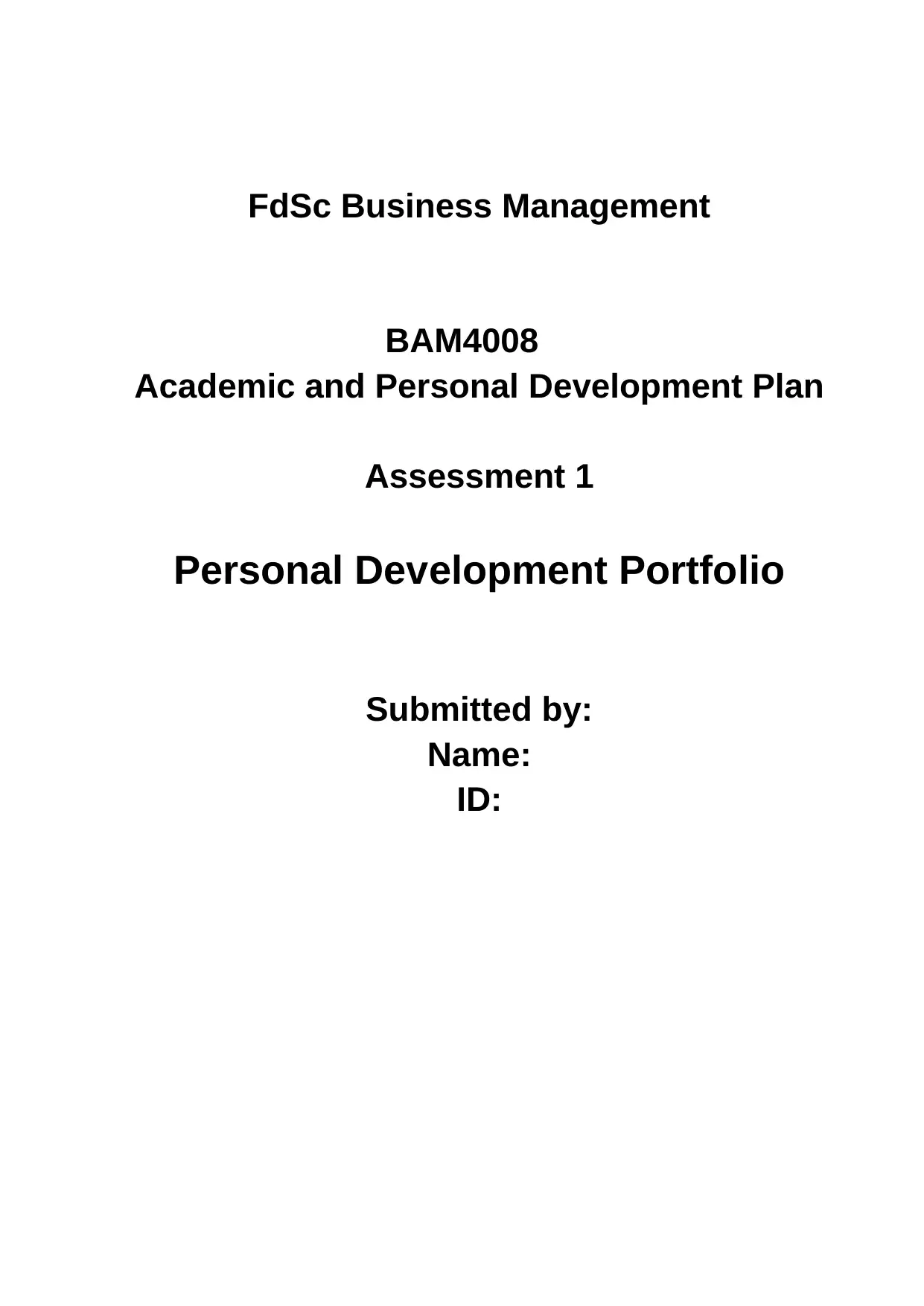
FdSc Business Management
BAM4008
Academic and Personal Development Plan
Assessment 1
Personal Development Portfolio
Submitted by:
Name:
ID:
BAM4008
Academic and Personal Development Plan
Assessment 1
Personal Development Portfolio
Submitted by:
Name:
ID:
Paraphrase This Document
Need a fresh take? Get an instant paraphrase of this document with our AI Paraphraser

Contents
2
2
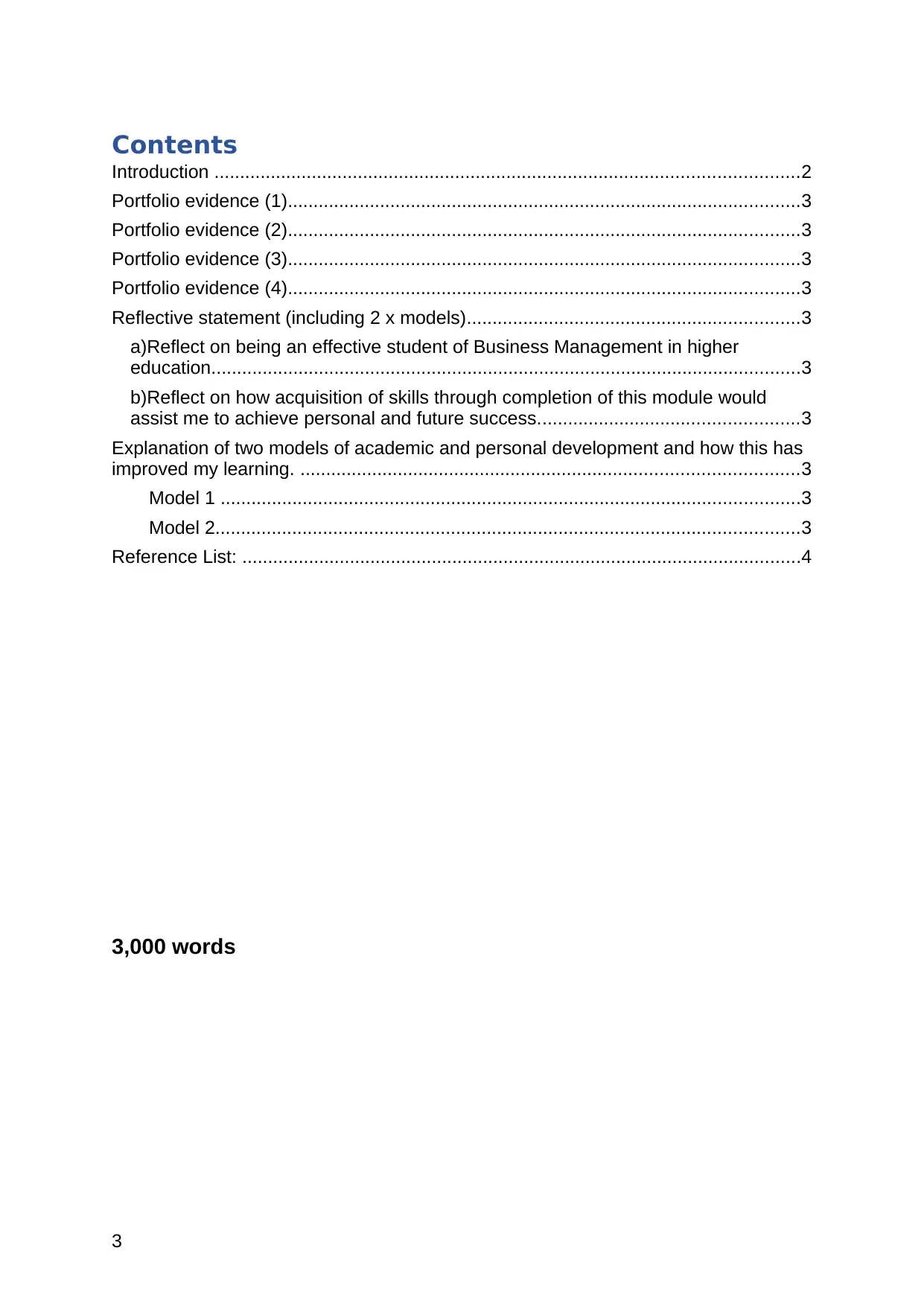
Contents
Introduction ..................................................................................................................2
Portfolio evidence (1)....................................................................................................3
Portfolio evidence (2)....................................................................................................3
Portfolio evidence (3)....................................................................................................3
Portfolio evidence (4)....................................................................................................3
Reflective statement (including 2 x models).................................................................3
a)Reflect on being an effective student of Business Management in higher
education...................................................................................................................3
b)Reflect on how acquisition of skills through completion of this module would
assist me to achieve personal and future success...................................................3
Explanation of two models of academic and personal development and how this has
improved my learning. .................................................................................................3
Model 1 .................................................................................................................3
Model 2..................................................................................................................3
Reference List: .............................................................................................................4
3,000 words
3
Introduction ..................................................................................................................2
Portfolio evidence (1)....................................................................................................3
Portfolio evidence (2)....................................................................................................3
Portfolio evidence (3)....................................................................................................3
Portfolio evidence (4)....................................................................................................3
Reflective statement (including 2 x models).................................................................3
a)Reflect on being an effective student of Business Management in higher
education...................................................................................................................3
b)Reflect on how acquisition of skills through completion of this module would
assist me to achieve personal and future success...................................................3
Explanation of two models of academic and personal development and how this has
improved my learning. .................................................................................................3
Model 1 .................................................................................................................3
Model 2..................................................................................................................3
Reference List: .............................................................................................................4
3,000 words
3
⊘ This is a preview!⊘
Do you want full access?
Subscribe today to unlock all pages.

Trusted by 1+ million students worldwide

Introduction
The purpose of this project is to elaborate the concepts and terms related to academic
and personal development. This report reflects on the academic skills required for higher
education in the field of business management. For this assessment, personal and professional
development plan is discussed which helps in acknowledging capabilities and potential and
allows enhancement of skills through addressing aims and objectives. Personal and
professional development is highly significant in order to develop personal traits necessary
for career enhancement. This report emphasize on personal development portfolio which
covers important theories and relevant terms related to academic and professional skill
development.
Portfolio evidence (1)
Goal setting
It refers to the process of preparing an action plan which is created for the purpose of
establishing guidelines to direct an individual towards determined objectives or motives.
Setting goals is the first step in the process of future planning and is extremely significant in
skill development in both personal as well as professional aspects (Houston.,2022). Goal
setting is critical in order to conduct planning in systematic and efficient manner which
ensures clarity of objectives and outcomes. The practice of goal-setting enables an individual
to solidify their commitments towards certain objectives thereby ensuring success in long
run. It helps in attaining clarity of outcomes according to which an individual perform his
course of action with behavioral conduct.
Goal A: In order to increase the chances of goal accomplishment, one should make sure that
all the means and resources are available required for fulfillment of objectives. The methods
and actions should be clearly defined which must be executed for attainment of defined goal.
I know that for the purpose of fulfillment of my goals, I need to enlist means and resources
which are necessary.
Goal B: I have set a goal focused on enhancement and development of my communication
skills. In order to increase possibilities of goal accomplishment, I would firstly determine
means and resources required in the action plan. For instance, I have examined that I need to
attend personality development programs where activities of self expression and interaction
are promoted. For this, I need to acknowledge requirements of funds and also conduct search
on such sessions near me.
4
The purpose of this project is to elaborate the concepts and terms related to academic
and personal development. This report reflects on the academic skills required for higher
education in the field of business management. For this assessment, personal and professional
development plan is discussed which helps in acknowledging capabilities and potential and
allows enhancement of skills through addressing aims and objectives. Personal and
professional development is highly significant in order to develop personal traits necessary
for career enhancement. This report emphasize on personal development portfolio which
covers important theories and relevant terms related to academic and professional skill
development.
Portfolio evidence (1)
Goal setting
It refers to the process of preparing an action plan which is created for the purpose of
establishing guidelines to direct an individual towards determined objectives or motives.
Setting goals is the first step in the process of future planning and is extremely significant in
skill development in both personal as well as professional aspects (Houston.,2022). Goal
setting is critical in order to conduct planning in systematic and efficient manner which
ensures clarity of objectives and outcomes. The practice of goal-setting enables an individual
to solidify their commitments towards certain objectives thereby ensuring success in long
run. It helps in attaining clarity of outcomes according to which an individual perform his
course of action with behavioral conduct.
Goal A: In order to increase the chances of goal accomplishment, one should make sure that
all the means and resources are available required for fulfillment of objectives. The methods
and actions should be clearly defined which must be executed for attainment of defined goal.
I know that for the purpose of fulfillment of my goals, I need to enlist means and resources
which are necessary.
Goal B: I have set a goal focused on enhancement and development of my communication
skills. In order to increase possibilities of goal accomplishment, I would firstly determine
means and resources required in the action plan. For instance, I have examined that I need to
attend personality development programs where activities of self expression and interaction
are promoted. For this, I need to acknowledge requirements of funds and also conduct search
on such sessions near me.
4
Paraphrase This Document
Need a fresh take? Get an instant paraphrase of this document with our AI Paraphraser
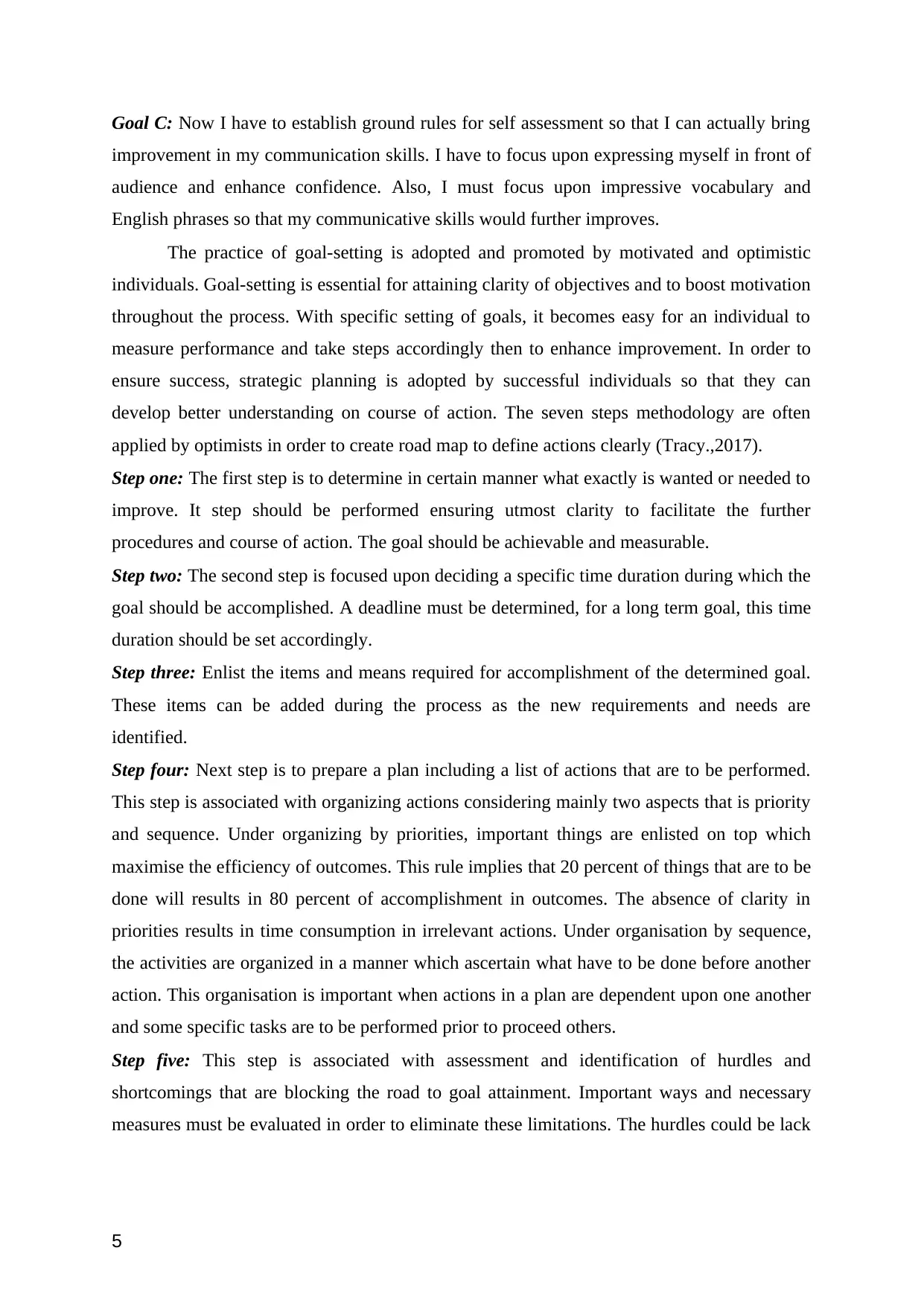
Goal C: Now I have to establish ground rules for self assessment so that I can actually bring
improvement in my communication skills. I have to focus upon expressing myself in front of
audience and enhance confidence. Also, I must focus upon impressive vocabulary and
English phrases so that my communicative skills would further improves.
The practice of goal-setting is adopted and promoted by motivated and optimistic
individuals. Goal-setting is essential for attaining clarity of objectives and to boost motivation
throughout the process. With specific setting of goals, it becomes easy for an individual to
measure performance and take steps accordingly then to enhance improvement. In order to
ensure success, strategic planning is adopted by successful individuals so that they can
develop better understanding on course of action. The seven steps methodology are often
applied by optimists in order to create road map to define actions clearly (Tracy.,2017).
Step one: The first step is to determine in certain manner what exactly is wanted or needed to
improve. It step should be performed ensuring utmost clarity to facilitate the further
procedures and course of action. The goal should be achievable and measurable.
Step two: The second step is focused upon deciding a specific time duration during which the
goal should be accomplished. A deadline must be determined, for a long term goal, this time
duration should be set accordingly.
Step three: Enlist the items and means required for accomplishment of the determined goal.
These items can be added during the process as the new requirements and needs are
identified.
Step four: Next step is to prepare a plan including a list of actions that are to be performed.
This step is associated with organizing actions considering mainly two aspects that is priority
and sequence. Under organizing by priorities, important things are enlisted on top which
maximise the efficiency of outcomes. This rule implies that 20 percent of things that are to be
done will results in 80 percent of accomplishment in outcomes. The absence of clarity in
priorities results in time consumption in irrelevant actions. Under organisation by sequence,
the activities are organized in a manner which ascertain what have to be done before another
action. This organisation is important when actions in a plan are dependent upon one another
and some specific tasks are to be performed prior to proceed others.
Step five: This step is associated with assessment and identification of hurdles and
shortcomings that are blocking the road to goal attainment. Important ways and necessary
measures must be evaluated in order to eliminate these limitations. The hurdles could be lack
5
improvement in my communication skills. I have to focus upon expressing myself in front of
audience and enhance confidence. Also, I must focus upon impressive vocabulary and
English phrases so that my communicative skills would further improves.
The practice of goal-setting is adopted and promoted by motivated and optimistic
individuals. Goal-setting is essential for attaining clarity of objectives and to boost motivation
throughout the process. With specific setting of goals, it becomes easy for an individual to
measure performance and take steps accordingly then to enhance improvement. In order to
ensure success, strategic planning is adopted by successful individuals so that they can
develop better understanding on course of action. The seven steps methodology are often
applied by optimists in order to create road map to define actions clearly (Tracy.,2017).
Step one: The first step is to determine in certain manner what exactly is wanted or needed to
improve. It step should be performed ensuring utmost clarity to facilitate the further
procedures and course of action. The goal should be achievable and measurable.
Step two: The second step is focused upon deciding a specific time duration during which the
goal should be accomplished. A deadline must be determined, for a long term goal, this time
duration should be set accordingly.
Step three: Enlist the items and means required for accomplishment of the determined goal.
These items can be added during the process as the new requirements and needs are
identified.
Step four: Next step is to prepare a plan including a list of actions that are to be performed.
This step is associated with organizing actions considering mainly two aspects that is priority
and sequence. Under organizing by priorities, important things are enlisted on top which
maximise the efficiency of outcomes. This rule implies that 20 percent of things that are to be
done will results in 80 percent of accomplishment in outcomes. The absence of clarity in
priorities results in time consumption in irrelevant actions. Under organisation by sequence,
the activities are organized in a manner which ascertain what have to be done before another
action. This organisation is important when actions in a plan are dependent upon one another
and some specific tasks are to be performed prior to proceed others.
Step five: This step is associated with assessment and identification of hurdles and
shortcomings that are blocking the road to goal attainment. Important ways and necessary
measures must be evaluated in order to eliminate these limitations. The hurdles could be lack
5
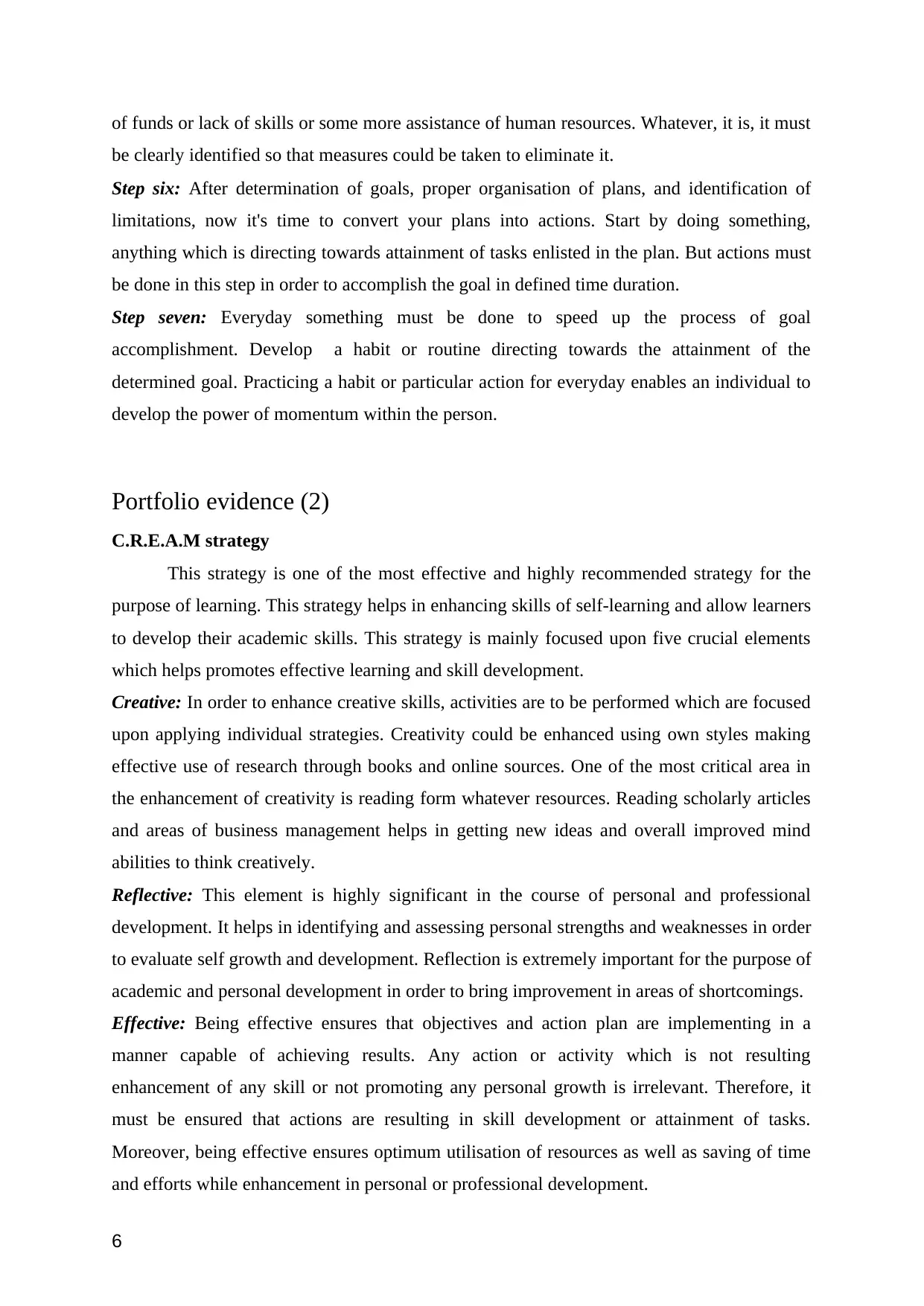
of funds or lack of skills or some more assistance of human resources. Whatever, it is, it must
be clearly identified so that measures could be taken to eliminate it.
Step six: After determination of goals, proper organisation of plans, and identification of
limitations, now it's time to convert your plans into actions. Start by doing something,
anything which is directing towards attainment of tasks enlisted in the plan. But actions must
be done in this step in order to accomplish the goal in defined time duration.
Step seven: Everyday something must be done to speed up the process of goal
accomplishment. Develop a habit or routine directing towards the attainment of the
determined goal. Practicing a habit or particular action for everyday enables an individual to
develop the power of momentum within the person.
Portfolio evidence (2)
C.R.E.A.M strategy
This strategy is one of the most effective and highly recommended strategy for the
purpose of learning. This strategy helps in enhancing skills of self-learning and allow learners
to develop their academic skills. This strategy is mainly focused upon five crucial elements
which helps promotes effective learning and skill development.
Creative: In order to enhance creative skills, activities are to be performed which are focused
upon applying individual strategies. Creativity could be enhanced using own styles making
effective use of research through books and online sources. One of the most critical area in
the enhancement of creativity is reading form whatever resources. Reading scholarly articles
and areas of business management helps in getting new ideas and overall improved mind
abilities to think creatively.
Reflective: This element is highly significant in the course of personal and professional
development. It helps in identifying and assessing personal strengths and weaknesses in order
to evaluate self growth and development. Reflection is extremely important for the purpose of
academic and personal development in order to bring improvement in areas of shortcomings.
Effective: Being effective ensures that objectives and action plan are implementing in a
manner capable of achieving results. Any action or activity which is not resulting
enhancement of any skill or not promoting any personal growth is irrelevant. Therefore, it
must be ensured that actions are resulting in skill development or attainment of tasks.
Moreover, being effective ensures optimum utilisation of resources as well as saving of time
and efforts while enhancement in personal or professional development.
6
be clearly identified so that measures could be taken to eliminate it.
Step six: After determination of goals, proper organisation of plans, and identification of
limitations, now it's time to convert your plans into actions. Start by doing something,
anything which is directing towards attainment of tasks enlisted in the plan. But actions must
be done in this step in order to accomplish the goal in defined time duration.
Step seven: Everyday something must be done to speed up the process of goal
accomplishment. Develop a habit or routine directing towards the attainment of the
determined goal. Practicing a habit or particular action for everyday enables an individual to
develop the power of momentum within the person.
Portfolio evidence (2)
C.R.E.A.M strategy
This strategy is one of the most effective and highly recommended strategy for the
purpose of learning. This strategy helps in enhancing skills of self-learning and allow learners
to develop their academic skills. This strategy is mainly focused upon five crucial elements
which helps promotes effective learning and skill development.
Creative: In order to enhance creative skills, activities are to be performed which are focused
upon applying individual strategies. Creativity could be enhanced using own styles making
effective use of research through books and online sources. One of the most critical area in
the enhancement of creativity is reading form whatever resources. Reading scholarly articles
and areas of business management helps in getting new ideas and overall improved mind
abilities to think creatively.
Reflective: This element is highly significant in the course of personal and professional
development. It helps in identifying and assessing personal strengths and weaknesses in order
to evaluate self growth and development. Reflection is extremely important for the purpose of
academic and personal development in order to bring improvement in areas of shortcomings.
Effective: Being effective ensures that objectives and action plan are implementing in a
manner capable of achieving results. Any action or activity which is not resulting
enhancement of any skill or not promoting any personal growth is irrelevant. Therefore, it
must be ensured that actions are resulting in skill development or attainment of tasks.
Moreover, being effective ensures optimum utilisation of resources as well as saving of time
and efforts while enhancement in personal or professional development.
6
⊘ This is a preview!⊘
Do you want full access?
Subscribe today to unlock all pages.

Trusted by 1+ million students worldwide
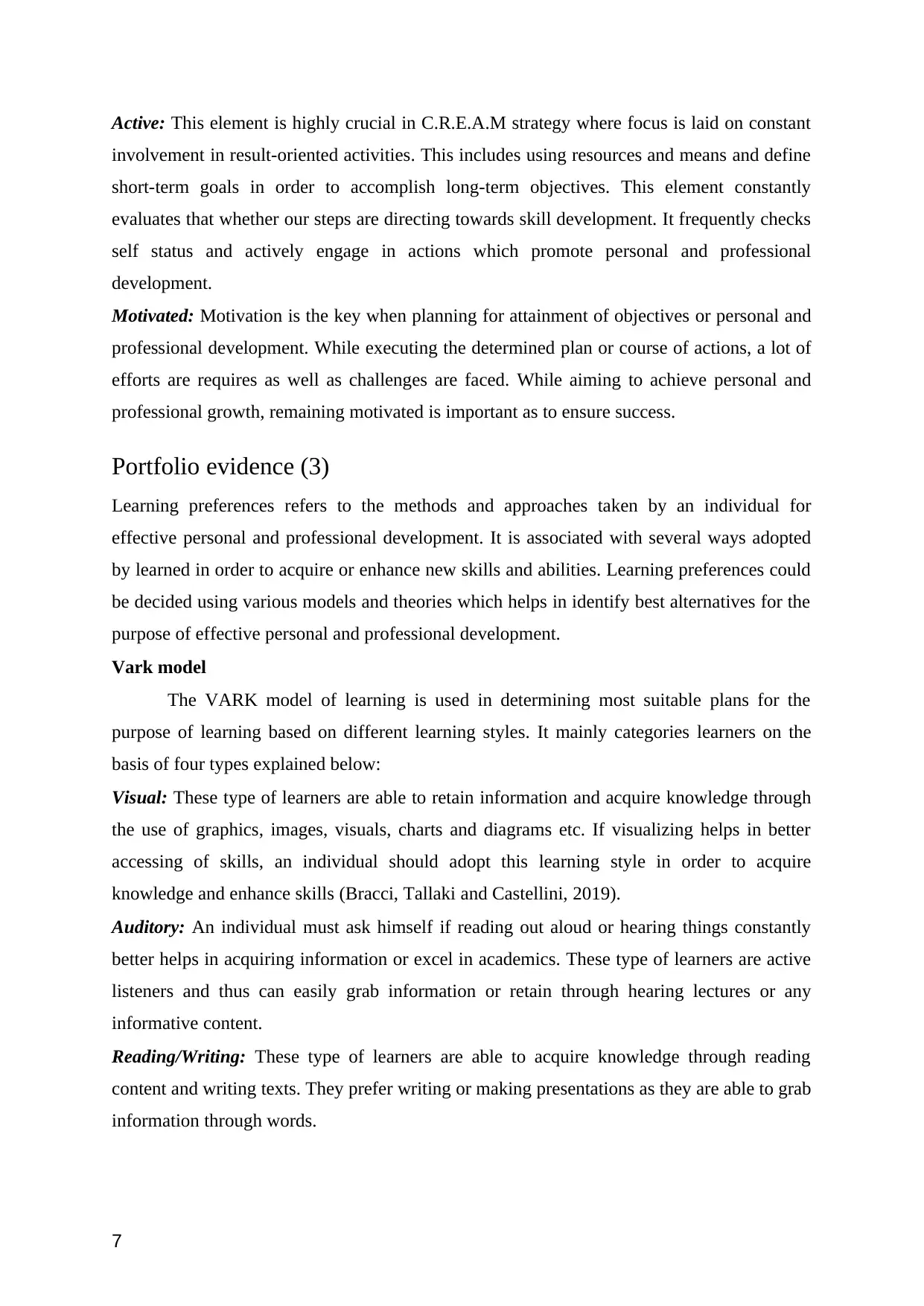
Active: This element is highly crucial in C.R.E.A.M strategy where focus is laid on constant
involvement in result-oriented activities. This includes using resources and means and define
short-term goals in order to accomplish long-term objectives. This element constantly
evaluates that whether our steps are directing towards skill development. It frequently checks
self status and actively engage in actions which promote personal and professional
development.
Motivated: Motivation is the key when planning for attainment of objectives or personal and
professional development. While executing the determined plan or course of actions, a lot of
efforts are requires as well as challenges are faced. While aiming to achieve personal and
professional growth, remaining motivated is important as to ensure success.
Portfolio evidence (3)
Learning preferences refers to the methods and approaches taken by an individual for
effective personal and professional development. It is associated with several ways adopted
by learned in order to acquire or enhance new skills and abilities. Learning preferences could
be decided using various models and theories which helps in identify best alternatives for the
purpose of effective personal and professional development.
Vark model
The VARK model of learning is used in determining most suitable plans for the
purpose of learning based on different learning styles. It mainly categories learners on the
basis of four types explained below:
Visual: These type of learners are able to retain information and acquire knowledge through
the use of graphics, images, visuals, charts and diagrams etc. If visualizing helps in better
accessing of skills, an individual should adopt this learning style in order to acquire
knowledge and enhance skills (Bracci, Tallaki and Castellini, 2019).
Auditory: An individual must ask himself if reading out aloud or hearing things constantly
better helps in acquiring information or excel in academics. These type of learners are active
listeners and thus can easily grab information or retain through hearing lectures or any
informative content.
Reading/Writing: These type of learners are able to acquire knowledge through reading
content and writing texts. They prefer writing or making presentations as they are able to grab
information through words.
7
involvement in result-oriented activities. This includes using resources and means and define
short-term goals in order to accomplish long-term objectives. This element constantly
evaluates that whether our steps are directing towards skill development. It frequently checks
self status and actively engage in actions which promote personal and professional
development.
Motivated: Motivation is the key when planning for attainment of objectives or personal and
professional development. While executing the determined plan or course of actions, a lot of
efforts are requires as well as challenges are faced. While aiming to achieve personal and
professional growth, remaining motivated is important as to ensure success.
Portfolio evidence (3)
Learning preferences refers to the methods and approaches taken by an individual for
effective personal and professional development. It is associated with several ways adopted
by learned in order to acquire or enhance new skills and abilities. Learning preferences could
be decided using various models and theories which helps in identify best alternatives for the
purpose of effective personal and professional development.
Vark model
The VARK model of learning is used in determining most suitable plans for the
purpose of learning based on different learning styles. It mainly categories learners on the
basis of four types explained below:
Visual: These type of learners are able to retain information and acquire knowledge through
the use of graphics, images, visuals, charts and diagrams etc. If visualizing helps in better
accessing of skills, an individual should adopt this learning style in order to acquire
knowledge and enhance skills (Bracci, Tallaki and Castellini, 2019).
Auditory: An individual must ask himself if reading out aloud or hearing things constantly
better helps in acquiring information or excel in academics. These type of learners are active
listeners and thus can easily grab information or retain through hearing lectures or any
informative content.
Reading/Writing: These type of learners are able to acquire knowledge through reading
content and writing texts. They prefer writing or making presentations as they are able to grab
information through words.
7
Paraphrase This Document
Need a fresh take? Get an instant paraphrase of this document with our AI Paraphraser
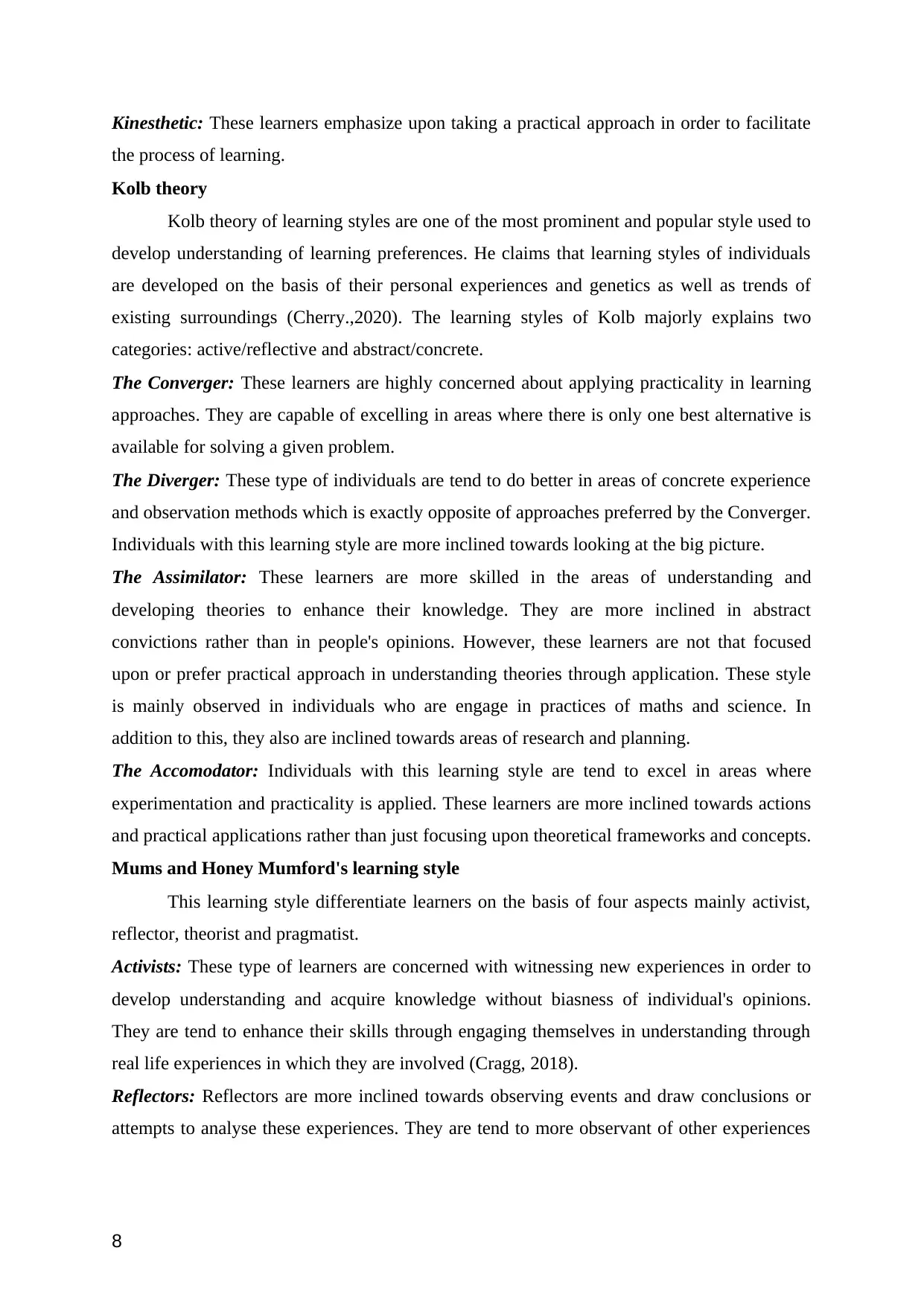
Kinesthetic: These learners emphasize upon taking a practical approach in order to facilitate
the process of learning.
Kolb theory
Kolb theory of learning styles are one of the most prominent and popular style used to
develop understanding of learning preferences. He claims that learning styles of individuals
are developed on the basis of their personal experiences and genetics as well as trends of
existing surroundings (Cherry.,2020). The learning styles of Kolb majorly explains two
categories: active/reflective and abstract/concrete.
The Converger: These learners are highly concerned about applying practicality in learning
approaches. They are capable of excelling in areas where there is only one best alternative is
available for solving a given problem.
The Diverger: These type of individuals are tend to do better in areas of concrete experience
and observation methods which is exactly opposite of approaches preferred by the Converger.
Individuals with this learning style are more inclined towards looking at the big picture.
The Assimilator: These learners are more skilled in the areas of understanding and
developing theories to enhance their knowledge. They are more inclined in abstract
convictions rather than in people's opinions. However, these learners are not that focused
upon or prefer practical approach in understanding theories through application. These style
is mainly observed in individuals who are engage in practices of maths and science. In
addition to this, they also are inclined towards areas of research and planning.
The Accomodator: Individuals with this learning style are tend to excel in areas where
experimentation and practicality is applied. These learners are more inclined towards actions
and practical applications rather than just focusing upon theoretical frameworks and concepts.
Mums and Honey Mumford's learning style
This learning style differentiate learners on the basis of four aspects mainly activist,
reflector, theorist and pragmatist.
Activists: These type of learners are concerned with witnessing new experiences in order to
develop understanding and acquire knowledge without biasness of individual's opinions.
They are tend to enhance their skills through engaging themselves in understanding through
real life experiences in which they are involved (Cragg, 2018).
Reflectors: Reflectors are more inclined towards observing events and draw conclusions or
attempts to analyse these experiences. They are tend to more observant of other experiences
8
the process of learning.
Kolb theory
Kolb theory of learning styles are one of the most prominent and popular style used to
develop understanding of learning preferences. He claims that learning styles of individuals
are developed on the basis of their personal experiences and genetics as well as trends of
existing surroundings (Cherry.,2020). The learning styles of Kolb majorly explains two
categories: active/reflective and abstract/concrete.
The Converger: These learners are highly concerned about applying practicality in learning
approaches. They are capable of excelling in areas where there is only one best alternative is
available for solving a given problem.
The Diverger: These type of individuals are tend to do better in areas of concrete experience
and observation methods which is exactly opposite of approaches preferred by the Converger.
Individuals with this learning style are more inclined towards looking at the big picture.
The Assimilator: These learners are more skilled in the areas of understanding and
developing theories to enhance their knowledge. They are more inclined in abstract
convictions rather than in people's opinions. However, these learners are not that focused
upon or prefer practical approach in understanding theories through application. These style
is mainly observed in individuals who are engage in practices of maths and science. In
addition to this, they also are inclined towards areas of research and planning.
The Accomodator: Individuals with this learning style are tend to excel in areas where
experimentation and practicality is applied. These learners are more inclined towards actions
and practical applications rather than just focusing upon theoretical frameworks and concepts.
Mums and Honey Mumford's learning style
This learning style differentiate learners on the basis of four aspects mainly activist,
reflector, theorist and pragmatist.
Activists: These type of learners are concerned with witnessing new experiences in order to
develop understanding and acquire knowledge without biasness of individual's opinions.
They are tend to enhance their skills through engaging themselves in understanding through
real life experiences in which they are involved (Cragg, 2018).
Reflectors: Reflectors are more inclined towards observing events and draw conclusions or
attempts to analyse these experiences. They are tend to more observant of other experiences
8
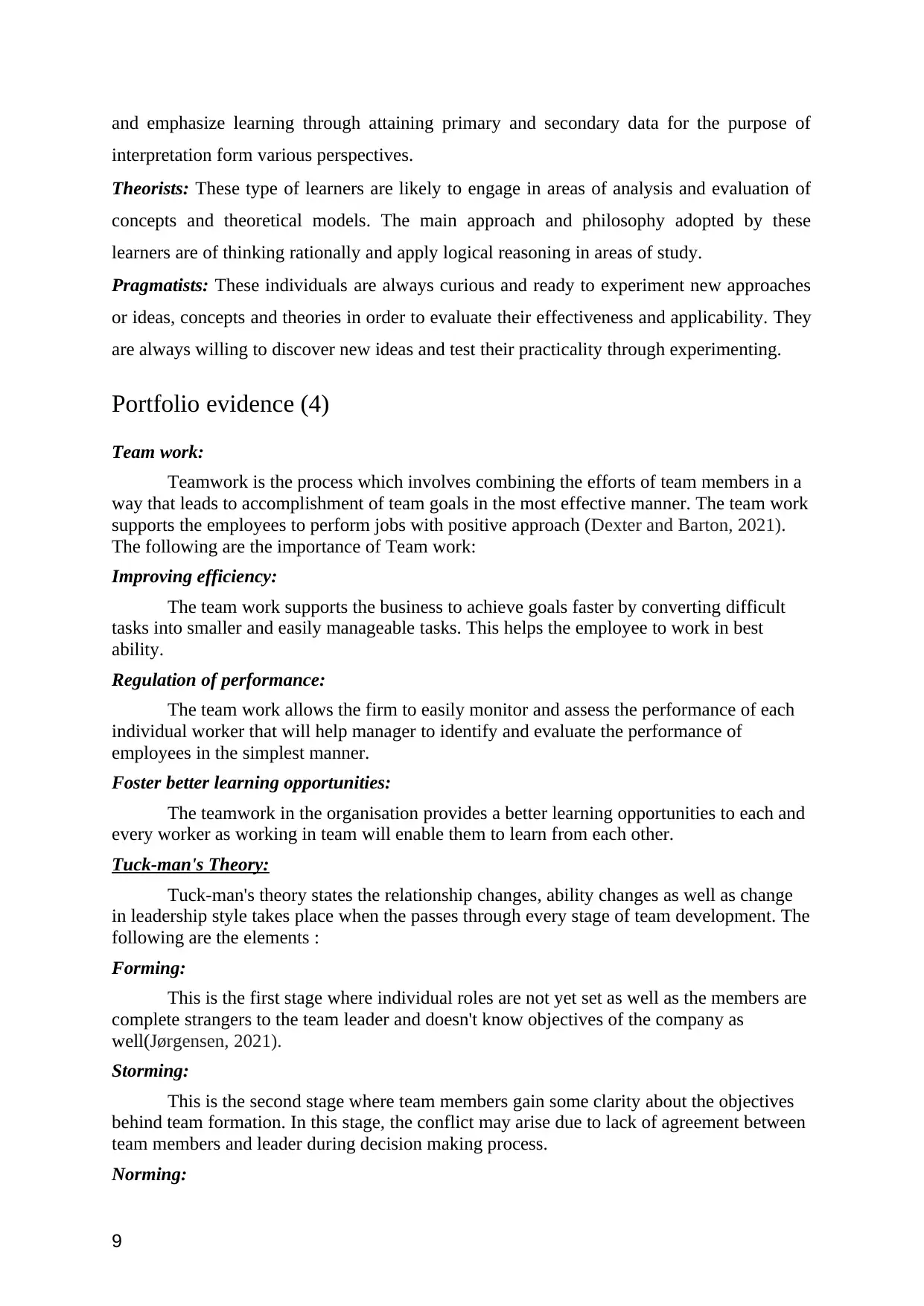
and emphasize learning through attaining primary and secondary data for the purpose of
interpretation form various perspectives.
Theorists: These type of learners are likely to engage in areas of analysis and evaluation of
concepts and theoretical models. The main approach and philosophy adopted by these
learners are of thinking rationally and apply logical reasoning in areas of study.
Pragmatists: These individuals are always curious and ready to experiment new approaches
or ideas, concepts and theories in order to evaluate their effectiveness and applicability. They
are always willing to discover new ideas and test their practicality through experimenting.
Portfolio evidence (4)
Team work:
Teamwork is the process which involves combining the efforts of team members in a
way that leads to accomplishment of team goals in the most effective manner. The team work
supports the employees to perform jobs with positive approach (Dexter and Barton, 2021).
The following are the importance of Team work:
Improving efficiency:
The team work supports the business to achieve goals faster by converting difficult
tasks into smaller and easily manageable tasks. This helps the employee to work in best
ability.
Regulation of performance:
The team work allows the firm to easily monitor and assess the performance of each
individual worker that will help manager to identify and evaluate the performance of
employees in the simplest manner.
Foster better learning opportunities:
The teamwork in the organisation provides a better learning opportunities to each and
every worker as working in team will enable them to learn from each other.
Tuck-man's Theory:
Tuck-man's theory states the relationship changes, ability changes as well as change
in leadership style takes place when the passes through every stage of team development. The
following are the elements :
Forming:
This is the first stage where individual roles are not yet set as well as the members are
complete strangers to the team leader and doesn't know objectives of the company as
well(Jørgensen, 2021).
Storming:
This is the second stage where team members gain some clarity about the objectives
behind team formation. In this stage, the conflict may arise due to lack of agreement between
team members and leader during decision making process.
Norming:
9
interpretation form various perspectives.
Theorists: These type of learners are likely to engage in areas of analysis and evaluation of
concepts and theoretical models. The main approach and philosophy adopted by these
learners are of thinking rationally and apply logical reasoning in areas of study.
Pragmatists: These individuals are always curious and ready to experiment new approaches
or ideas, concepts and theories in order to evaluate their effectiveness and applicability. They
are always willing to discover new ideas and test their practicality through experimenting.
Portfolio evidence (4)
Team work:
Teamwork is the process which involves combining the efforts of team members in a
way that leads to accomplishment of team goals in the most effective manner. The team work
supports the employees to perform jobs with positive approach (Dexter and Barton, 2021).
The following are the importance of Team work:
Improving efficiency:
The team work supports the business to achieve goals faster by converting difficult
tasks into smaller and easily manageable tasks. This helps the employee to work in best
ability.
Regulation of performance:
The team work allows the firm to easily monitor and assess the performance of each
individual worker that will help manager to identify and evaluate the performance of
employees in the simplest manner.
Foster better learning opportunities:
The teamwork in the organisation provides a better learning opportunities to each and
every worker as working in team will enable them to learn from each other.
Tuck-man's Theory:
Tuck-man's theory states the relationship changes, ability changes as well as change
in leadership style takes place when the passes through every stage of team development. The
following are the elements :
Forming:
This is the first stage where individual roles are not yet set as well as the members are
complete strangers to the team leader and doesn't know objectives of the company as
well(Jørgensen, 2021).
Storming:
This is the second stage where team members gain some clarity about the objectives
behind team formation. In this stage, the conflict may arise due to lack of agreement between
team members and leader during decision making process.
Norming:
9
⊘ This is a preview!⊘
Do you want full access?
Subscribe today to unlock all pages.

Trusted by 1+ million students worldwide
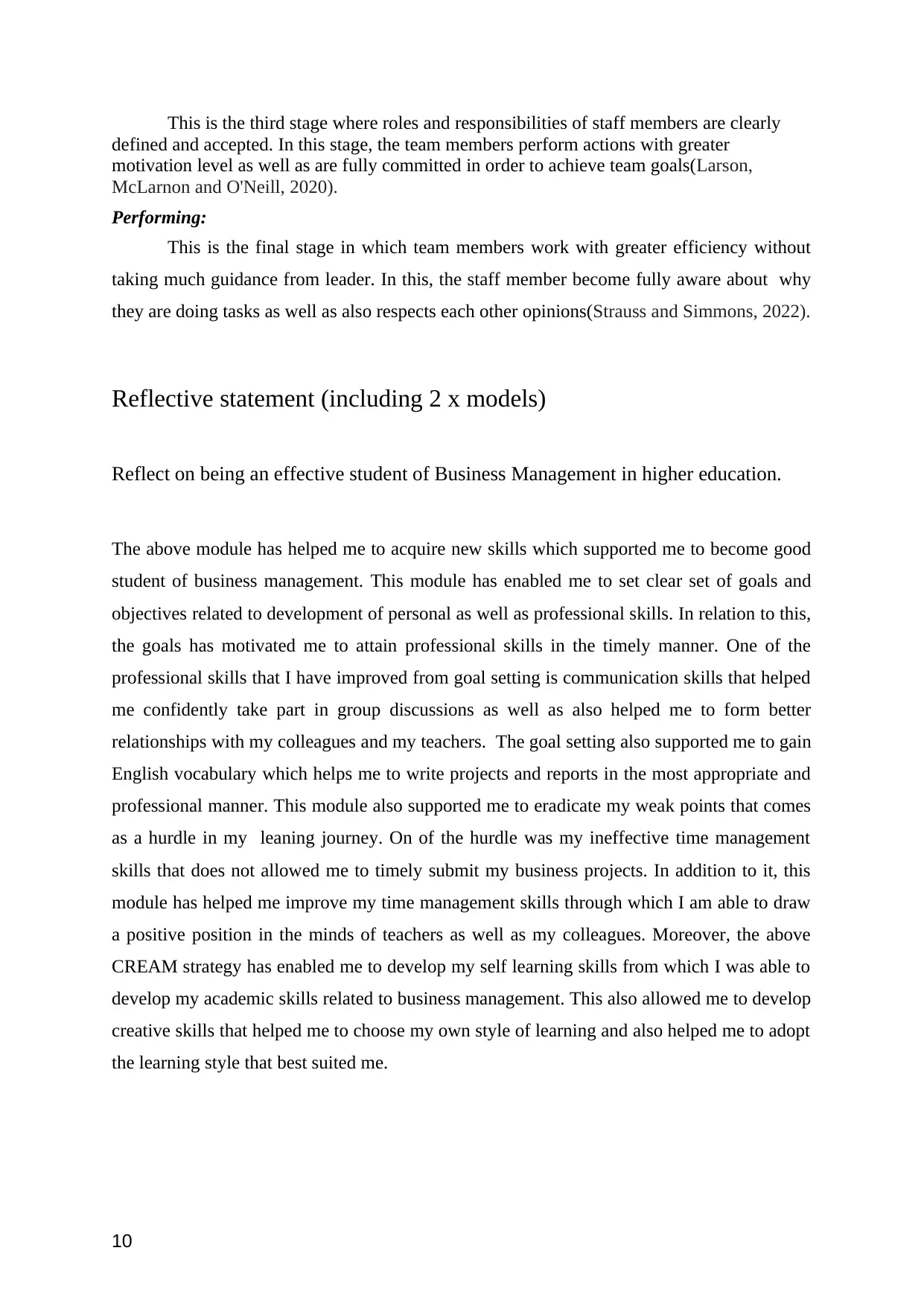
This is the third stage where roles and responsibilities of staff members are clearly
defined and accepted. In this stage, the team members perform actions with greater
motivation level as well as are fully committed in order to achieve team goals(Larson,
McLarnon and O'Neill, 2020).
Performing:
This is the final stage in which team members work with greater efficiency without
taking much guidance from leader. In this, the staff member become fully aware about why
they are doing tasks as well as also respects each other opinions(Strauss and Simmons, 2022).
Reflective statement (including 2 x models)
Reflect on being an effective student of Business Management in higher education.
The above module has helped me to acquire new skills which supported me to become good
student of business management. This module has enabled me to set clear set of goals and
objectives related to development of personal as well as professional skills. In relation to this,
the goals has motivated me to attain professional skills in the timely manner. One of the
professional skills that I have improved from goal setting is communication skills that helped
me confidently take part in group discussions as well as also helped me to form better
relationships with my colleagues and my teachers. The goal setting also supported me to gain
English vocabulary which helps me to write projects and reports in the most appropriate and
professional manner. This module also supported me to eradicate my weak points that comes
as a hurdle in my leaning journey. On of the hurdle was my ineffective time management
skills that does not allowed me to timely submit my business projects. In addition to it, this
module has helped me improve my time management skills through which I am able to draw
a positive position in the minds of teachers as well as my colleagues. Moreover, the above
CREAM strategy has enabled me to develop my self learning skills from which I was able to
develop my academic skills related to business management. This also allowed me to develop
creative skills that helped me to choose my own style of learning and also helped me to adopt
the learning style that best suited me.
10
defined and accepted. In this stage, the team members perform actions with greater
motivation level as well as are fully committed in order to achieve team goals(Larson,
McLarnon and O'Neill, 2020).
Performing:
This is the final stage in which team members work with greater efficiency without
taking much guidance from leader. In this, the staff member become fully aware about why
they are doing tasks as well as also respects each other opinions(Strauss and Simmons, 2022).
Reflective statement (including 2 x models)
Reflect on being an effective student of Business Management in higher education.
The above module has helped me to acquire new skills which supported me to become good
student of business management. This module has enabled me to set clear set of goals and
objectives related to development of personal as well as professional skills. In relation to this,
the goals has motivated me to attain professional skills in the timely manner. One of the
professional skills that I have improved from goal setting is communication skills that helped
me confidently take part in group discussions as well as also helped me to form better
relationships with my colleagues and my teachers. The goal setting also supported me to gain
English vocabulary which helps me to write projects and reports in the most appropriate and
professional manner. This module also supported me to eradicate my weak points that comes
as a hurdle in my leaning journey. On of the hurdle was my ineffective time management
skills that does not allowed me to timely submit my business projects. In addition to it, this
module has helped me improve my time management skills through which I am able to draw
a positive position in the minds of teachers as well as my colleagues. Moreover, the above
CREAM strategy has enabled me to develop my self learning skills from which I was able to
develop my academic skills related to business management. This also allowed me to develop
creative skills that helped me to choose my own style of learning and also helped me to adopt
the learning style that best suited me.
10
Paraphrase This Document
Need a fresh take? Get an instant paraphrase of this document with our AI Paraphraser
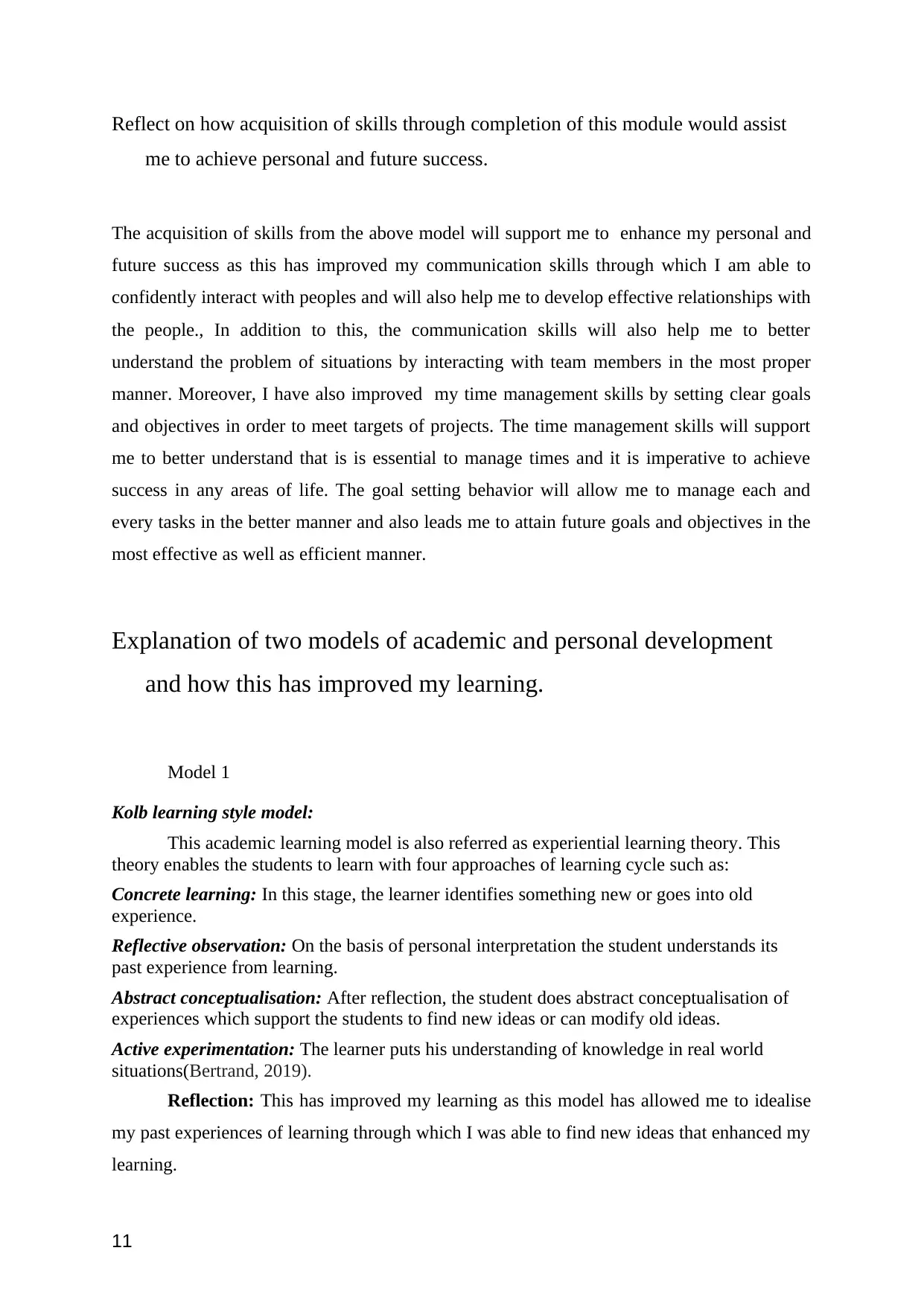
Reflect on how acquisition of skills through completion of this module would assist
me to achieve personal and future success.
The acquisition of skills from the above model will support me to enhance my personal and
future success as this has improved my communication skills through which I am able to
confidently interact with peoples and will also help me to develop effective relationships with
the people., In addition to this, the communication skills will also help me to better
understand the problem of situations by interacting with team members in the most proper
manner. Moreover, I have also improved my time management skills by setting clear goals
and objectives in order to meet targets of projects. The time management skills will support
me to better understand that is is essential to manage times and it is imperative to achieve
success in any areas of life. The goal setting behavior will allow me to manage each and
every tasks in the better manner and also leads me to attain future goals and objectives in the
most effective as well as efficient manner.
Explanation of two models of academic and personal development
and how this has improved my learning.
Model 1
Kolb learning style model:
This academic learning model is also referred as experiential learning theory. This
theory enables the students to learn with four approaches of learning cycle such as:
Concrete learning: In this stage, the learner identifies something new or goes into old
experience.
Reflective observation: On the basis of personal interpretation the student understands its
past experience from learning.
Abstract conceptualisation: After reflection, the student does abstract conceptualisation of
experiences which support the students to find new ideas or can modify old ideas.
Active experimentation: The learner puts his understanding of knowledge in real world
situations(Bertrand, 2019).
Reflection: This has improved my learning as this model has allowed me to idealise
my past experiences of learning through which I was able to find new ideas that enhanced my
learning.
11
me to achieve personal and future success.
The acquisition of skills from the above model will support me to enhance my personal and
future success as this has improved my communication skills through which I am able to
confidently interact with peoples and will also help me to develop effective relationships with
the people., In addition to this, the communication skills will also help me to better
understand the problem of situations by interacting with team members in the most proper
manner. Moreover, I have also improved my time management skills by setting clear goals
and objectives in order to meet targets of projects. The time management skills will support
me to better understand that is is essential to manage times and it is imperative to achieve
success in any areas of life. The goal setting behavior will allow me to manage each and
every tasks in the better manner and also leads me to attain future goals and objectives in the
most effective as well as efficient manner.
Explanation of two models of academic and personal development
and how this has improved my learning.
Model 1
Kolb learning style model:
This academic learning model is also referred as experiential learning theory. This
theory enables the students to learn with four approaches of learning cycle such as:
Concrete learning: In this stage, the learner identifies something new or goes into old
experience.
Reflective observation: On the basis of personal interpretation the student understands its
past experience from learning.
Abstract conceptualisation: After reflection, the student does abstract conceptualisation of
experiences which support the students to find new ideas or can modify old ideas.
Active experimentation: The learner puts his understanding of knowledge in real world
situations(Bertrand, 2019).
Reflection: This has improved my learning as this model has allowed me to idealise
my past experiences of learning through which I was able to find new ideas that enhanced my
learning.
11

Model 2
VARK learning style model:
This model supports the student to learn necessary information through Visual,
auditory, reading and Kinaesthetic learning styles. This model assists the academic learner to
adopt the most suitable approach for learning on the basis of their needs.
Reflection: This model has supported my learning journey by providing different
ways to learn new things in the most suitable manner. It supported me to get better in reading
as well as writing skills that helped to gain better results in my exams. This has also allowed
me to excel in my academic career(Cochran, Neumayer and Elder, 2019).
Reference List:
Books and Journals
Bracci, E., Tallaki, M. and Castellini, M., 2019. Learning preferences in accounting
education: a focus on the role of visualization. Meditari Accountancy Research.
Cragg, R., 2018. Growing new leaders. In How to Succeed as a Leader (pp. 105-112). CRC
Press.
Houston.,2022,What is Goal Setting and How to Do it Well, 2022. [Online]. Available
through: <https://positivepsychology.com/goal-setting/>
Tracy.,2017,The 7-Step Formula for Goal Setting, 2017. [Online]. Available through:
<https://www.entrepreneur.com/article/297205>
Cherry.,2020,Kolb's Theory of Learning Styles, 2020. [Online]. Available through:
<https://www.verywellmind.com/kolbs-learning-styles-2795155>
Dexter, S. and Barton, E. A., 2021. The development and impact of team-based school
technology leadership. Journal of Educational Administration.
Jørgensen, M., 2021, September. Team Resource Management Decisions in Software
Development Projects. In 2021 IEEE 23rd Conference on Business Informatics
(CBI) (Vol. 1, pp. 1-10). IEEE.
Larson, N. L., McLarnon, M. J. and O'Neill, T. A., 2020. Challenging the “static” quo:
Trajectories of engagement in team processes toward a deadline. Journal of Applied
Psychology, 105(10). p.1145.
Strauss, F. and Simmons, K., 2022. The Wolverine CubeSat Development Team: Middle
Schools Students as Agents for Aerospace Education Outreach. In AIAA SCITECH
2022 Forum (p. 1348).
12
VARK learning style model:
This model supports the student to learn necessary information through Visual,
auditory, reading and Kinaesthetic learning styles. This model assists the academic learner to
adopt the most suitable approach for learning on the basis of their needs.
Reflection: This model has supported my learning journey by providing different
ways to learn new things in the most suitable manner. It supported me to get better in reading
as well as writing skills that helped to gain better results in my exams. This has also allowed
me to excel in my academic career(Cochran, Neumayer and Elder, 2019).
Reference List:
Books and Journals
Bracci, E., Tallaki, M. and Castellini, M., 2019. Learning preferences in accounting
education: a focus on the role of visualization. Meditari Accountancy Research.
Cragg, R., 2018. Growing new leaders. In How to Succeed as a Leader (pp. 105-112). CRC
Press.
Houston.,2022,What is Goal Setting and How to Do it Well, 2022. [Online]. Available
through: <https://positivepsychology.com/goal-setting/>
Tracy.,2017,The 7-Step Formula for Goal Setting, 2017. [Online]. Available through:
<https://www.entrepreneur.com/article/297205>
Cherry.,2020,Kolb's Theory of Learning Styles, 2020. [Online]. Available through:
<https://www.verywellmind.com/kolbs-learning-styles-2795155>
Dexter, S. and Barton, E. A., 2021. The development and impact of team-based school
technology leadership. Journal of Educational Administration.
Jørgensen, M., 2021, September. Team Resource Management Decisions in Software
Development Projects. In 2021 IEEE 23rd Conference on Business Informatics
(CBI) (Vol. 1, pp. 1-10). IEEE.
Larson, N. L., McLarnon, M. J. and O'Neill, T. A., 2020. Challenging the “static” quo:
Trajectories of engagement in team processes toward a deadline. Journal of Applied
Psychology, 105(10). p.1145.
Strauss, F. and Simmons, K., 2022. The Wolverine CubeSat Development Team: Middle
Schools Students as Agents for Aerospace Education Outreach. In AIAA SCITECH
2022 Forum (p. 1348).
12
⊘ This is a preview!⊘
Do you want full access?
Subscribe today to unlock all pages.

Trusted by 1+ million students worldwide
1 out of 13
Related Documents
Your All-in-One AI-Powered Toolkit for Academic Success.
+13062052269
info@desklib.com
Available 24*7 on WhatsApp / Email
![[object Object]](/_next/static/media/star-bottom.7253800d.svg)
Unlock your academic potential
Copyright © 2020–2025 A2Z Services. All Rights Reserved. Developed and managed by ZUCOL.
